Isabella Bradford's Blog, page 27
October 8, 2017
A Gilded Fan in the Gothic Style
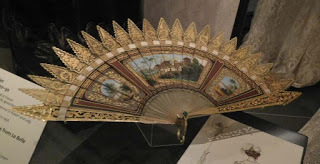 Loretta reports:
Loretta reports:The Regency/Romantic era fashions in the V&A Museum included, along with the turban and fan I showed you a while ago, this rather more elaborate fan. As you can see (and probably see better if you enlarge the image at the V&A collections website, it’s quite elaborate, with three entire scenes painted with gouache, and the gilded, lacy sticks. The museum classifies this as Gothic Revival—and I’ve noticed that the Gothic seems to be revived rather frequently, in architecture and fashion, right up to our own time. The museum explains also that the fan sticks "were further embellished with crocketing - small projections along the points - inspired by the gables and spires of Gothic churches.”
Dated between 1820-1840, it does strike me as the sort of accessory I’d expect post-Regency, when fashions started becoming more ornate and showy. Certainly I have no trouble imagining one of my 1830s characters wielding such a fan, while one of my Regency ladies would be more likely to be
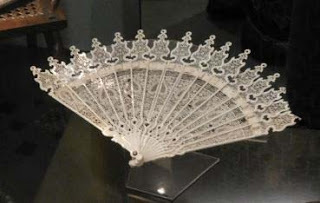 fluttering something like the one in my earlier blog post, shown here at right. This one, too, can be enlarged and examined in more detail at the V&A website
here
.
fluttering something like the one in my earlier blog post, shown here at right. This one, too, can be enlarged and examined in more detail at the V&A website
here
. Photographs courtesy me.
Please click on the images to enlarge.
Published on October 08, 2017 21:30
October 7, 2017
Breakfast Links: Week of October 2, 2017
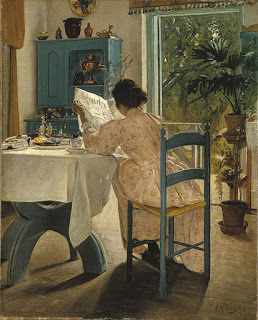 Breakfast Links are served - our weekly round-up of fav links to other web sites, articles, blogs, and images via Twitter.
Breakfast Links are served - our weekly round-up of fav links to other web sites, articles, blogs, and images via Twitter.• Vice wars: New York City's scandalous censorship past.
• Paul Revere's midnight ride - by day, in a car.
• Aboard the Dashing Wave : a passenger's journal from a 1859 clipper ship.
• Women who went to war in 1861: the Civil War vivandieres .
• Which side would you choose? Family ties and the British occupation of Philadelphia during the American Revolution; part II here .
• "How many stamens has your flower?": The botanical education of Emily Dickinson .
• Image: Late 3rd-early 2ndc BC gold earrings with pendants of flying Nike with torch.
• Why did the great Gilded Age mansions lose their luster?
• Image: Fanny Brawne's fashion notebook.
• Forgotten wartime doughnut heroines.
• The first monument in New York's Central Park wasn't to a general or politician, but to a German poet .
• The myth of Robert E. Lee and the "good" slave-owner.
• Image: "The cruel seas , remember, took him in November," 1592.
• Marie Duval , the pioneering 19thc cartoonist that history forgot.
• Paisley shawls from a visit to the Paisley Museum (original article is in Spanish; even if you don't read Spanish or have a translation feature, the photos are stunning.)
• Poconos & Catskills resorts (think Dirty Dancing) idyllic in 1960s postcards compared to abandoned disrepair today.
• Nellie Bly , intrepid journalist.
• Image: The New York City house where Louisa May Alcott lived while writing Little Women.
• James MacLaine , the gentleman highwayman.
• Thomas Carr of Lincoln, dealer of almanacks and...fish.
• Inside an iconic 1977 Playboy Bunny uniform .
• Video: Truly amazing video: how fourteen wolves changed the ecosystem of Yellowstone National Park .
Hungry for more? Follow us on Twitter @2nerdyhistgirls for fresh updates daily.
Above: At Breakfast by Laurits Andersen Ring. Private collection
Published on October 07, 2017 14:00
Save the Date: Booksigning & Talk for I, ELIZA HAMILTON on October 14
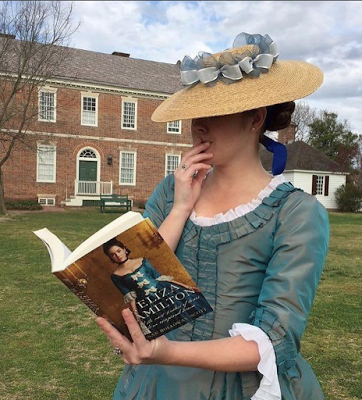 Susan reporting,
Susan reporting,Next Saturday, October 14, I'll be speaking and signing books at 1:00 pm in the McChesney Room of the Schenectady County Public Library, 99 Clinton Street, Schenectady, NY. For more information, please call the library: 518-388-4500.
If you'd like to order a book for me to sign AND receive a 20% discount, please call the Open Door Bookstore (they'll be handling the book sales for the signing) by October 10: 518-346-2719.
This is a special signing for me because it's in the Schenectady-Albany area. My heroine, Elizabeth Schuyler Hamilton, was born in Albany, and her family's house - then known as The Pastures and now The Schuyler Mansion - still stands.
Hope to see you there - and especially if you're a blog-follower, please be sure to introduce yourself!
Published on October 07, 2017 09:00
Save the Date! Booksigning & Talk for I, ELIZA HAMILTON on October 14
 Susan reporting,
Susan reporting,Next Saturday, October 14, I'll be speaking and signing books at 1:00 pm in the McChesney Room of the Schenectady County Public Library, 99 Clinton Street, Schenectady, NY. For more information, please call the library: 518-388-4500.
If you'd like to order a book for me to sign AND receive a 20% discount, please call the Open Door Bookstore (they'll be handling the book sales for the signing) by October 10: 518-346-2719.
This is a special signing for me because it's in the Schenectady-Albany area. My heroine, Elizabeth Schuyler Hamilton, was born in Albany, and her family's house - then known as The Pastures and now The Schuyler Mansion - still stands.
Hope to see you there - and especially if you're a blog-follower, please be sure to introduce yourself!
Published on October 07, 2017 09:00
October 5, 2017
Friday Video: Sparkly Little Pink Coat by Balenciaga
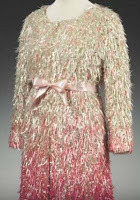 Loretta reports:
Loretta reports:On a blog post a while back, I offered some images from the Balenciaga, Shaping Fashion exhibition at the Victoria & Albert Museum .
Today’s video will give you an idea of the level of artistry and amount of work that went into one element of making a single garment displayed in the exhibition. After you view it, I strongly recommend you take a look at the closeups of the pink, feathery coat on the V&A website.
You might also want to take a look at some of the other V&A videos dealing with the exhibition. They’re short, and, among other things, provide some glimpses of the Conservation Department and its work, which I had the rare privilege of visiting, thanks to a thoughtful friend from London.*
The image above left is a still from the video, since nowhere, in the thousands of photos my husband and I took during this year’s travels, could I find one of this particular item. But then, none of our photos, shot through glass, would have been nearly as crisply close up as those on the V&A website.
*I mean you, Betsy!
V&A video: Lesage and Balenciaga, via YouTube
Clicking on the image will enlarge it, but it will be fuzzy.
Published on October 05, 2017 21:30
Friday VIdeo: Sparkly Little Pink Coat by Balenciaga
 Loretta reports:
Loretta reports:On a blog post a while back, I offered some images from the Balenciaga, Shaping Fashion exhibition at the Victoria & Albert Museum .
Today’s video will give you an idea of the level of artistry and amount of work that went into one element of making a single garment displayed in the exhibition. After you view it, I strongly recommend you take a look at the closeups of the pink, feathery coat on the V&A website.
You might also want to take a look at some of the other V&A videos dealing with the exhibition. They’re short, and, among other things, provide some glimpses of the Conservation Department and its work, which I had the rare privilege of visiting, thanks to a thoughtful friend from London.*
The image above left is a still from the video, since nowhere, in the thousands of photos my husband and I took during this year’s travels, could I find one of this particular item. But then, none of our photos, shot through glass, would have been nearly as crisply close up as those on the V&A website.
*I mean you, Betsy!
V&A video: Lesage and Balenciaga, via YouTube
Clicking on the image will enlarge it, but it will be fuzzy.
Published on October 05, 2017 21:30
October 4, 2017
From the Archives: Alexander Hamilton Seeks a Wife, 1779
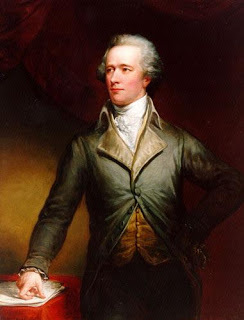 Susan reporting:
Susan reporting:One of the questions that authors are asked most frequently is "Where do you get your ideas?" Most of the time, there's no specific answer. I really don't know, especially since years can pass between that first flickering idea to a full-fledged book.
While searching for something else (as if often the case), I found this blog post from February 2011. I'd forgotten entirely about it (which often happens, too), but clearly I was already thinking about Elizabeth Schuyler and Alexander Hamilton more than six years ago, and likely longer. I certainly didn't know then that a blog post would eventually grow into my new historical novel, I, Eliza Hamilton, but here you are: the birth of a book-idea. Maybe.
No matter the time period, finding the perfect spouse seems to have been a constant challenge for men and women alike. Matchmaking today may have become one more internet transaction, but in the past, most people turned to friends and family to help them find a suitable mate. And in the past, just as today, the laundry-list of requirements in a potential spouse that the hopeful bride or groom sought must have sorely tried the patience of a good many friends.
Alexander Hamilton (1757-1804), left, was one of early America's Founding Fathers, and is most remembered today as the first U.S. Secretary of the Treasury. But in April, 1779, he was an ambitious young lieutenant colonel serving in the Continental Army as an aide to General George Washington, and one of the ways he hoped to rise in the world was to make a favorable marriage. In a letter to his good friend and fellow officer John Laurens, he enlisted Laurens' assistance in finding just the right lady:
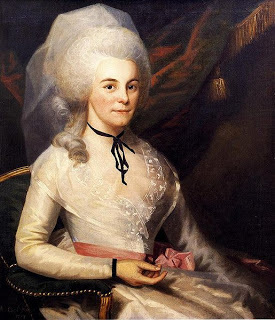 "Such a wife as I want will, I know, be difficult to be found, but if you succeed, it will be the stronger proof of your zeal and dexterity. Take her description – She must be young, handsome (I lay most stress upon a good shape) sensible (a little learning will do), well bred (but she must have an aversion to the word ton) chaste and tender (I am an enthusiast in my notions of fidelity and fondness) of some good nature, a great deal of generosity (she must neither love money nor scolding, for I dislike equally a termagant and an economist). In politics, I am indifferent what side she may be of; I think I have arguments that will easily convert her to mine. As to religion a moderate stock will satisfy me. She must believe in God and hate a saint. But as to fortune, the larger stock of that the better. You know my temper and circumstances and will therefore pay special attention to this article in the treaty. Though I run no risk of going to Purgatory for my avarice; yet as money is an essential ingredient to happiness in this world – as I have not much of my own and as I am very little calculated to get more either by my address or industry; it must needs be, that my wife, if I get one, bring at least a sufficiency to administer to her own extravagancies."
"Such a wife as I want will, I know, be difficult to be found, but if you succeed, it will be the stronger proof of your zeal and dexterity. Take her description – She must be young, handsome (I lay most stress upon a good shape) sensible (a little learning will do), well bred (but she must have an aversion to the word ton) chaste and tender (I am an enthusiast in my notions of fidelity and fondness) of some good nature, a great deal of generosity (she must neither love money nor scolding, for I dislike equally a termagant and an economist). In politics, I am indifferent what side she may be of; I think I have arguments that will easily convert her to mine. As to religion a moderate stock will satisfy me. She must believe in God and hate a saint. But as to fortune, the larger stock of that the better. You know my temper and circumstances and will therefore pay special attention to this article in the treaty. Though I run no risk of going to Purgatory for my avarice; yet as money is an essential ingredient to happiness in this world – as I have not much of my own and as I am very little calculated to get more either by my address or industry; it must needs be, that my wife, if I get one, bring at least a sufficiency to administer to her own extravagancies."Amazingly, Hamilton soon did find himself a wife who met nearly all of these stipulations. Elizabeth Schuyler (1757-1854), right, was the daughter of General Philip Schuyler, and a member of one of the wealthiest and most influential families in New York. Hamilton wed her in December, 1780, in her family's mansion. The marriage produced eight children and survived Hamilton's various scandals and a very public infidelity, and for the duration of Elizabeth's long life (she outlived her husband – killed in the famous duel with Aaron Burr – by fifty years), she defended Hamilton and refused to believe the gossip about him, no matter how true it might have been.
So perhaps despite the seemingly mercenary beginning, Alexander Hamilton really did get lucky and wed the girl of his dreams....
Published on October 04, 2017 21:00
October 2, 2017
Fashions for October 1871
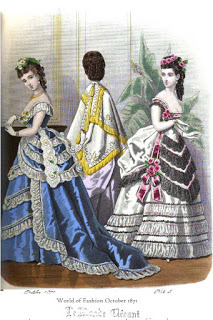 October 1871 fashions
Loretta reports:
October 1871 fashions
Loretta reports:The October 1871 issue of The World of Fashion calls our attention to something we might rarely think about: the influence of political events on fashion. Fashion in some cases, apparently, took itself to a calmer environment, and proceeded as usual.
“It is now more than twelve months, since the siege of Paris occasioned the total collapse of Fashion in the French capital, and for nearly nine months afterwards no new Fashions could be produced in that city. Attempts were indeed made, to carry on some of the French Journals of Fashion in other continental capitals, but owing to the force of circumstances nothing really new was produced there, and their Costumes were merely repetitions, or rather exaggerations of the fashions of the Empire, including the enormous bouffants and all kinds of extravagance and bad taste.
“The proprietors of this Magazine, however, had foreseen the probable course of events, and when the fortune of War declared against “La Belle France,” they advised their staff of artists and Artistes des Modes, to seek refuge in London. They did so, and carried on, uninterruptedly, their production of elegant creations, combining with them something of the English taste acquired during their stay.
“At the same time, England being freed from all chance of entanglement in the disastrous conflict then raging on the Continent, became the natural place of refuge for the elite of Parisian Society, and thus Fashion made her usual progress, without the least retardation; in fact it then combined the brilliancy of French ideas, with the well known simplicity and elegance of the English taste.”
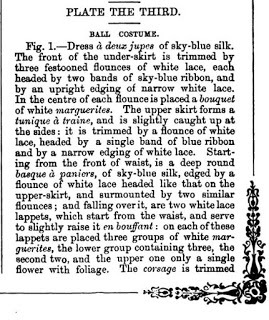 October 1871 fashions description
If you compare with
last month’s fashions
, you’ll note the way the shape of the skirt is changing, beginning to flatten in the front, and gathering up in the back as we progress toward that late-Victorian emphasis on the booty.
October 1871 fashions description
If you compare with
last month’s fashions
, you’ll note the way the shape of the skirt is changing, beginning to flatten in the front, and gathering up in the back as we progress toward that late-Victorian emphasis on the booty.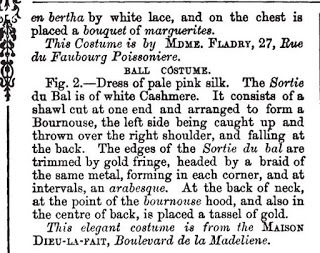
 Fashion plate and quotations from The World of Fashion and Continental Feuilletons [afterw.] The Ladies' Monthly Magazine, The World of Fashion [afterw.] Le Monde Élégant; or The World of Fashion Vol 48 Jan – Dec 1871 via Google Books.
Fashion plate and quotations from The World of Fashion and Continental Feuilletons [afterw.] The Ladies' Monthly Magazine, The World of Fashion [afterw.] Le Monde Élégant; or The World of Fashion Vol 48 Jan – Dec 1871 via Google Books.Clicking on the image will enlarge it. Clicking on the caption will take you to the source, where you can learn more and enlarge images as needed.
Published on October 02, 2017 21:30
October 1, 2017
The Wedding Ring that Alexander Hamilton Gave to Elizabeth Schuyler, 1780
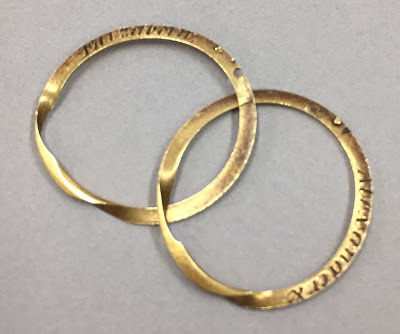 Susan reporting,
Susan reporting,As I've noted in previous blog posts ( here and here ), sometimes the most inspiring historical research isn't found in books, diaries, or letters, but in the physical objects that can offer an immediate connection to the past. I've saved the best of these from my research for my just-released historical novel I, Eliza Hamilton until now - and here it is.
Kept in an acid-free box in the Rare Book & Manuscript Library at Columbia University in New York City, and tiny in size, it's only brought out by special request, or for the even-more-rare times that it appears on display as part of an exhibition.
It's Eliza Schuyler Hamilton's wedding ring. THE wedding ring, the one that Alexander Hamilton slipped on her finger when they were married in December, 1780 .
Made of gold grown burnished with time in the way that only wedding rings can be, Eliza's ring is impossibly delicate, worn thin and no longer exactly round after nearly seventy-four years on her finger. It's small, too, for Eliza was a petite woman. I wasn't permitted to try it on (nor would I have wished to: that's Eliza's ring), but when I placed my own size-5 ring beside it, mine looked large and thick by comparison.
The style is ingenious. It's called a gimmel ring (or gimmal, or puzzle ring), with two separate, twisted circles that are linked and fit together side by side to form a single band. Gimmel rings had already been popular for betrothals and weddings long before Alexander bought one for Eliza, with the earliest known examples dating from the 14th century. I made this very brief video showing the curator linking the rings together. If you look closely, you can see the little notch and peg that clicked the rings together.
The symbolism of two forming one is perfect for a marriage, and this ring was made even more special by having the names of the groom and bride - Alexander & Elizabeth (he got the ampersand) - engraved inside each ring, where they were always pressed against one another. Without the added enhancement of precious stones, this was a comparatively inexpensive ring, which was likely a consideration for the impoverished young lieutenant colonel in the middle of the American Revolution.
But I also imagine that the simplicity of the ring must have appealed to Eliza as well. There on her finger, the gold band must have been a constant comfort to her, a reminder of love and happiness through the tragedies and sorrows of her life, and through the half-century - more than fifty years! - of her widowhood.
Given that, I'm surprised that the ring was not buried with her. Yet I'm glad it wasn't. Seeing this little double-circle of gold, touching it lightly with my fingertip, was like having Eliza herself there beside me in the library. Research doesn't get any better - or more magical - than that.
Many thanks to Jennifer B. Lee, Curator, Rare Book & Manuscript Library, Columbia University, for showing me the ring along with other Hamilton memorabilia.
Above: Gold double-band wedding ring of Elizabeth Schuyler Hamilton, wife of Alexander Hamilton, maker unknown, 1780. Columbia University; gift of Furman University Library, through the suggestion and assistance of the Hamilton family descendants: Mrs. Marie Hamilton Barrett and Mrs. Elizabeth Schuyler Campbell.
Published on October 01, 2017 17:12
September 30, 2017
Breakfast Links: Week of September 25, 2017
 Breakfast Links are served - our weekly round-up of fav links to other web sites, articles, blogs, and images via Twitter.
Breakfast Links are served - our weekly round-up of fav links to other web sites, articles, blogs, and images via Twitter.• Patient hero: John Henry and the earliest American account of post-traumatic stress.
• Margaret Hamilton , the woman who put a man on the moon.
• The wedding feast of Philip the Good, Duke of Burgundy, and Isabel of Portugal, 1429.
• James Leman and the ravishing silk designs he created in 18thc Spitalfields.
• One of history's most reproduced "wallflowers": 19thc beauty, muse, and opera singer Lina Cavilieri.
• Image: A large, rare, and exquisite 17thc lady's needle lace toilette .
• The storied 18thc romance of Lady Frankland, born a fisherman's daughter, may not be the idealized fairy-tale it once seemed.
• Sugar versus honey in Byzantine recipes .
• Memento of a spy: the leather pocketbook British spy Major John Andre was carrying when he was captured by American soldiers, September 1780.
• Coin-op cuisine: when the future tasted like a five-cents slice of pie .
• Diverse entertainment at the 19thc Eagle Tavern in London.
• It's been fifty years since Britain left. Why do so many African judges still wear white Georgian-style wigs ?
• Image: Records show Queen Alexandra ordered matching shoes and stockings like these c1890.
• Queen Victoria's Hindustani diaries.
• Respectfully presented: an elegant " presentation sampler " worked by a 12-year-old Philadelphian in 1822.
• Thomas Rowlandsond's Lower Orders .
• In the 1930s, New Zealand had an epidemic of exploding pants .
• A calvary helmet designed by Lord Byron.
• The world's smallest crime scenes from the 1940s: the Nutshell Studies of Unexplained Death .
• When the King of France lived in England.
Hungry for more? Follow us on Twitter @2nerdyhistgirls for fresh updates daily.
Above: At Breakfast by Laurits Andersen Ring. Private collection
Published on September 30, 2017 14:00



